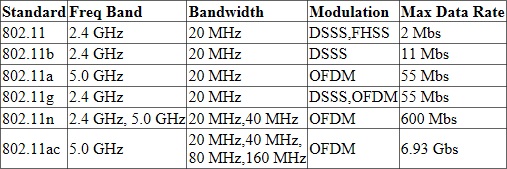IEEE 802.11.x Wireless Standards
By Stephen Bucaro

The 802.11 standard, approved in 1997, applies to wireless LANs with a 1 or 2 Mbps transmission rate in the
2.4 GHz band. Sometimes the term 802.11 is used to refer to the 802.11x family of specifications.
802.11b
In September of 1999, the IEEE extended the 802.11 standard, creating the 802.11b standard. It supports
a maximum bandwidth up to 11Mbps in the 2.4GHz S-Band Industrial, Scientific, and Medical (ISM)
frequency range. Being an unregulated frequency, 802.11b device can suffer from interference from
other wireless users, cordless phones, microwave ovens and other devices using the same 2.4 GHz band.
The 802.11b wireless standard uses CSMA/CA (Carrier Sense Multiple Access with Collision Avoidance)
similar to Ethernet. 802.11b circuits are specified to operate at a rate of 11 Mbps, but the system
monitors the signal quality. If the signal quality then the system can transmit at a slower data rate
with more error correction that is more resilient. Under poor quality conditions the system will first
fall back to 5.5 Mbps, then 2 Mbps, and finally 1 Mbps. This scheme is known as ARS (Adaptive Rate Selection).
802.11a
About the same time 802.11b was created, 802.11a was created. 802.11a supports a maximum bandwidth up
to 55Mbps in the 5GHz band. An advantage of 802.11a is that it operates at a radio frequency that's
less clogged by competing signals from other wireless users, cordless phones and microwave ovens.
But 802.11a was not popular due to the more expensive cost of 5GHz components and not being compatible with 802.11b.
The 802.11a wireless standard uses OFDM (Orthogonal Frequency Division Multiplexing), a transmission
technique that splits the signal into multiple smaller sub-signals that are then transmitted
simultaneously at different frequencies. Devices that use the 802.11a standard, if they are not dual
band (eg. 802.11a/b), are not compatible with any of the products that use the 2.5 GHz frequency (802.11b, g or n).
802.11g
With 802.11b not being compatible with 802.11a, there was still a need for higher bandwidth. In June 2003,
802.11g was released to provide maximum bandwidth up to 55Mbps in the 2.4GHz band. 802.11g is backward
compatible with 802.11b because they both use the same 2.4GHz radio frequency. However 802.11g again
suffers from the same interference as 802.11b in the crowded 2.4 GHz range, But 802.11g provides better
security features, such as WiFi Protected Access (WAP) and WPA2 authentication with pre-shared key or RADIUS server.
802.11n
In October 2009 the IEEE approved 802.11n wireless communication standard to provide a maximum bandwidth
up to 300Mbps. 802.11n can operate in the 2.4GHz or 5GHz band, and is backward compatible with 802.11a
(5GHz band), 802.11b (2.4GHz band) and 802.11g (2.4GHz band) devices.
The 802.11n standard supports MIMO (Multiple Input, Multiple Output) antennas. 802.11n operates on both
the 2.4 GHz and the 5 GHz bands. Support for 5 GHz bands is optional. It operates at a maximum net data
rate from 54 Mbps to 600 Mbps.
802.11ac
IEEE 802.11ac delivers speeds ranging from 433 Mbps up to several gigabits per second. It works
exclusively in the 5GHz band. 802.11ac operates up to eight MIMO (Multiple Input, Multiple Output) antennas.
It uses beamforming technology which sends the signal directly to client devices.
802.11i
In June 2004 the IEEE ratified the 802.11i standard. It provides no changes to the operating band or
maximum bandwidth of wireless communication, but instead specifies security mechanisms for wireless
networks. It replaces the Authentication and privacy clause of the original 802.11 standard which called
for WEP (Wired Equivalent Privacy), which was shown to have security vulnerabilities, with RSN (Robust
Security Network), which uses the Advanced Encryption Standard (AES) block cipher.
More Networking Protocols and Standards:
• Wireless Standards - 802.11a 802.11b 802.11g 802.11n 802.11i Explained
• The OSI Physical Layer
• IPv4 Address Classes
• TCP Windowing
• TCP/IP Protocol Suite
• Video - Data Link Layer of OSI Networking Model
• Video - The Upper Layers 5 Through 7 of the OSI Networking Model
• Pv6 Myths
• Session Border Controllers - More Than Just a Voice Firewall
• RADIUS Protocol
| 
